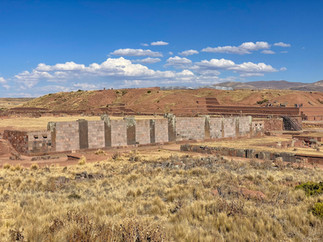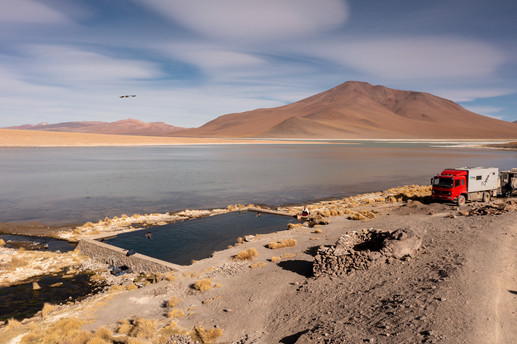CHOLITAS, COCA LEAVES & FLAMINGOS
- rouletout608
- Jul 23
- 11 min read
Lake Titicaca, many of you might have read the accounts of Alexander von Humboldt about this famous lake and from childhood on its name and Humboldt’s stories left this faint memory of a mysterious place in my mind. Now we crossed the border from Peru to Bolivia at the shores of this lake, the Cordillera Real with its snow capped peaks in the background of the dark blue water of this mystical lake. We followed the shores of the lake for the last days in Peru but now it was time to explore it a bit more.
Our first camp was just after the border in Copacabana, directly at the shores of the lake. The small town gave us a first taste of Bolivia, its Cholitas (indigenous women in traditional dresses), its sometimes surprising customs and its vibrant markets.
We took a boat to Isla del Sol and hiked across the island, visited its Inca ruins and enjoyed nature, the views and alpacas, donkeys and pigs that inhabit the island. Almost every day the Cholitas came together in town for some spectacle, dances or to just sell local stuff on the market so it was hard to leave for our next destination, Peñas.
Peñas is a small village about 50km from La Paz and - thanks to the work of an Italian priest - one of the most popular climbing spots in Bolivia. We also had planned to meet up there with our friends Rafa and Corina. The roads through the altiplano (the planes located above 4000m ASL) are small and many and somehow we lost the main track. As our bearing was still in direction of our destination we continued but just like 200m before reaching a solid road again Rouletout got stuck in the mud. A very old local man came by to help by putting dried animal feces in front of our tires but to no avail. Luckily Corina and Rafa showed up at about the same time and they pulled us out of our miserable situation. We still had a big ditch to cross to get on the main road so we decided to spend the night where we were and tackle the task on the next day. We talked to the old man and he explained that in the village was an Italian priest named Alberto and that he could help us with anything we might need.
While Rafa and Ulf started preparing the muddy section and the ditch for the next day, the girls took their chairs and started drinking wine. As Berna put it: we don’t have TV but at least we can watch our men working in a nice scenery. In the first years of our trip we maybe got angry or even panicked when we were stuck, now it is all about creating a relaxing environment and then addressing the problem.
The next day we filled the last ditch with stones, almost building a new road with Rafa and Corina working like Hercules and finally we arrived in Peñas. Not knowing where to stay we chose an empty field just outside the village with great views of the mountains. We asked a local passerby if it were ok to stay here and he mumbled something like “of course” but we can also check with father Alberto if we need anything. Father Alberto seems to be quite the man in Peñas.
The next morning we drove into the village to find father Alberto and inquire about the climbing spot. Next to church was a small tourism school ran by the church educating mountain guides for trips into the Cordillera Real. When we asked for father Alberto we only saw surprised faces, father Alberto passed away a few years ago! The new priest was father Antonio, also an Italian climber. He welcomed us and showed us a nice and flat spot just behind the church. He explained that for many years the locals were suspicious of foreigners and that it took a while for them to accept even him and the activities he offered in and around the village with the support of some Italian volunteers. By now most locals see the advantages and sell local cheese and liquor, opened a small restaurant that serves lasagne and tiramisu (as taught by the Italians) and help guide the few tourists through the area.
It feels quite strange to eat lasagne and tiramisu while watching cholitas with their beautiful costumes walking through the streets of the village.
After 10 days of climbing, exploring the mountains behind the village and cooking Rafa and Corina headed back to La Paz while we stayed on for a bit more before also heading to the capital.
On our way to La Paz we visited another archaeological site called Tiwanaku, almost got lost again on the small roads of the altiplano but finally made it to La Paz on a Thursday which means market day, not a great idea. The streets of La Paz are narrow and steep and it took us hours to get through the maze to the southern part of town where we parked our home at a nice viewpoint, overlooking the city built on steep slopes made out of gravel and dirt. There were no security guards but we felt it to be a safe place and started to explore this amazing city using the relatively new network of cable cars that criss cross the whole town. The city is located between 3000 and 4200m ASL and riding over the houses, the congested streets, cemeteries and markets is really a unique experience. Sometimes you pass very close over small courtyards full of life, people drinking and eating, doing laundry, fixing their motorbikes or just sitting together - it is almost like watching a TV series but in the background you see the snow capped peaks which, combined with the hum of the cable car, give you a ski resort feeling.
We stopped in El Alto, the famous (or infamous) part of town that is already on the altiplano and is mostly known for its huge market on Thursdays and Sundays. One section of the market deals with all “spiritual” items (also called the “witch market”), amongst them stuffed baby alpacas. Locals believe that they protect you and your house from bad luck or even bring luck, let’s just hope that these baby alpacas died of natural causes.
Another important utensil are hats. Cholitas have really nice hats - looking a bit like magician hats - that protect them from the sun and the cold. One hat maker showed us his ornate trade resulting in hats costing above US$200, a heavy investment for any cholita.
Everyone is selling something in La Paz, the only thing you don’t see are beggars. Begging is considered degrading so people try to sell whatever they find. An important ingredient for life at these altitudes are coca leaves. They are sold out of huge bags and often in combination with a chalk like substance that you add to the leave for chewing. This basic compound intensifies the effect of the leaves and thus helps to better eliminate the effects of high altitude. That it works is obvious when you are being passed by a heavily loaded cholita while walking uphill on the steep stairs of La Paz.
Coca leaves are also used for fortune telling which is a big business. A small district in El Alto surrounded by frog statues (they also bring luck) and small fires is dotted with small fortune teller offices and of course we decided to visit one. First of course you have to pay the lady and then she throws coca leaves in the air, sprinkles alcohol on the wall for some saint and depending on how the leaves fall she interprets your future. She asks you about health, money and for us most interesting, travel. Our lady didn’t like our plans of leaving La Paz and she strongly recommended to stay longer as we are going to run into troubles on that day. Soon we were about to find out that she was right :-).
There is a lot of street food in La Paz, nothing that really got us excited but one: Shiny red cinnamon ice cream which is often consumed at funerals as it is believed that it makes the mourners happy. Bolivia is full of spirits, superstition and believes…
The lower, central part of town is dominated by a few government sky scrapers surrounded by historical buildings. Some of them are literally falling apart and rumour has it that the money provided by the European Union to fix them went elsewhere. It also hosts several markets, amongst them a very nice “tourist market” with beautiful products made of alpaca wool and other local handicrafts.
To take a short break from the city we decided to do the famous mountain bike downhill from high above La Paz down into the jungle on the other side of the Cordillera Real, more than 3000m downhill on the once famous “Death Road” which by now is replaced by a much better and safer road. It was quite impressive and an interesting break from the high altitude, leaving at 4500m at below 0 degree and arriving in the jungle where we were able to swim in a pool and fight with mosquitos. Back in La Paz we stocked up on food to prepare for our next adventure but not before visiting the market in El Alto again and enjoying extensive cable car rides across town.
Our next destination was Uyuni, the famous salt flats that we had planned to explore with our friends Rafa and Corina. But first we had to get out of La Paz and here we come back to our fortune teller’s prediction.
One early morning we left our spot in southern La Paz to make our way up to the Alta Plano. We passed the famous Valle de las Animas (Valley of the Souls) and soon we started climbing the steep road towards the top. Just before reaching it, a long queue of trucks blocked our way. Hiking up to the top we discovered that this intersection (as most others in La Paz and El Alto) was blocked with busses and barricades and locals explained, that these are protests by the bus drivers in order to get a fare increase approved. The negotiations were ongoing and within a few hours this should be resolved, we decided to wait. A few hours later the situation was still the same but a friendly protestor explained a potential way out. He showed me a few landmarks further south and told me that this way might lead up to the Alta Plano without blocks. We turned around and tried to find the way but on the way up a truck stopped us, saying that it was also blocked. However, he said that he had another way out and that we should just follow him, which we did and to our surprise we made it up the Alta Plano into a shady part of El Alto just before sunset. The views of the mountains were amazing but our goal was to reach the main road south. We criss crossed through the small roads without names and soon we saw columns of black smoke in the not so far distance. Some of the road blocks on the main road were set on fire. As we approached the main road a group of men armed with big stones approached us. They were ready to throw them and didn’t look too friendly so Ulf decided to jump out of the car and approach them. After a few words they offered us coca leaves and said that it was better to disappear as it might get ugly. A few cholitas joined and explained that it was best to drive back and try the small roads parallel to the main road in direction south. By now it was dark and it was quite a challenge to find the way through dusty alleys, unmarked dead ends and deep ditches but in the end we made it out to the main road and continued for a while until we found a spot for the night up on a beautiful hill. Well, maybe we should have listened to our fortune teller :-).
On pretty good roads we crossed the Alti Plano through empty and beautiful landscapes towards Uyuni where we met up again with Rafa & Corina. We explored the small town, stocked up on the market and visited the famous train cemetery, remnants from the past when heavy trains carried valuable ores from the area. Now dozens of steam locomotives and wagons just slowly rust away in the middle of nowhere.
The salt flat of Uyuni (Salar de Uyuni) is just a few kilometres away from town. It is the world’s largest salt flat and the world’s largest completely flat area as the meter thick salt crust is “floating” on top of a lake. This, the clear skies at 3600m and the high reflectability of the salt make it ideal to calibrate satellites. We however were mostly attracted by the breathtaking landscape, the endless white is only interrupted by a couple of small islands. These and the edges of the salt crust are the only dangerous places. Once in a while you see pictures of campers sunk in when they get too close to the shore and the crust breaks, a really uncomfortable situation that we absolutely wanted to avoid.
Stocked up with food we followed a few traces to enter the salt flat and after some initial hesitation we sped west, just keeping a constant bearing in direction of the islands. We found a hole that allowed us to inspect the thickness of the salt crust and after a few hours and having taken hundreds of pictures in this otherworldly landscape we set up camp for the night.
Despite the cold we enjoyed an outstanding barbecue, (too) many singani sours (the Bolivian version of pisco sour) and we danced under the bright stars that seemed to shine just for us on the endless white salt flat.
On the next morning we were rewarded with a gorgeous sunrise and soon we started with the obligatory foto session. The loss of perspective makes for great opportunities for fun pictures - see for yourselves.
Our dogs also struggled with the loss of perspective. Once in a while another vehicle passed on the horizon and not knowing how far it was, they started chasing after it, only realising after a few hundred meters that the moving thing is beyond reach for them.
We visited the islands with their exceptional vegetation and after another night on the flats turned south towards the infamous laguna route. This road leads into the southwestern corner of Bolivia towards the border with Chile. Altitudes of up to 4500m, strangely coloured mountains and even more strangely coloured lakes full of flamingos and geysers dot this barren landscape. The washboard road is only interrupted by rocky sections but in the end we didn’t find it to be as bad as many people say.
We stopped every so often to admire the flamingos, the landscapes, rocks with strange shapes and the intensely blue sky. After a few days we stumbled on a hot spring, someone was building an endless pool in the middle of nowhere just above a lake and we made it our home for two nights. The first night we spent in the pool until early morning, watching the flamingos unfreeze from the frozen lake as the sun started to warm them - what a spectacle.
Not far from the border with Chile we decided to turn around and follow a different track back north towards Uyuni. We had planned a trip back to Europe and had to get organised and Rafa & Corina had to leave Bolivia as their visa ran out, so it was time to say goodbye for now, we really had a great time together.
Filling up in Bolivia is not that easy. Often diesel is not available and there are also two different prices for foreigners and locals. Luckily we have very big tanks so there was no urgency but we were still happy to buy a few hundred litres at the local price in a small village.
It also took us a while to find a decent car wash to get rid of the salt but on our way east through the famous mining town of Potosi we finally found one. Driving through the green landscapes on road 5 almost felt like summer despite the fact that we were still at 3500m.
We visited the beautiful colonial town of Sucre with its narrow and steep roads and then finally dropped down into the jungle towards Santa Cruz de la Sierra. We had a flight to Europe from there and had to prepare the truck and the dogs for their time without us. Just outside of Santa Cruz we found a lady that was willing to take care of our doggies and we were able to leave our truck in her garden. It was a beautiful place, the roads full of deep and fine sand, almost like on the beach and the Rio Pirai not far. We visited the town with our bike and soon it was time to leave Bolivia, the incredible landscapes, the cholitas, the mountains and its culture. Thank you Bolivia, we really had a great time.
Back from Europe we visited another corner of Bolivia but more on that and our adventures in the Pantanal and in Paraguay in our next blog entry.
















































































































































































Comments